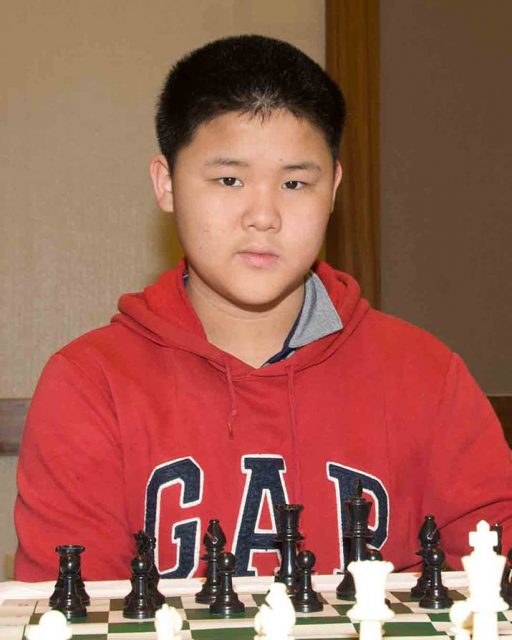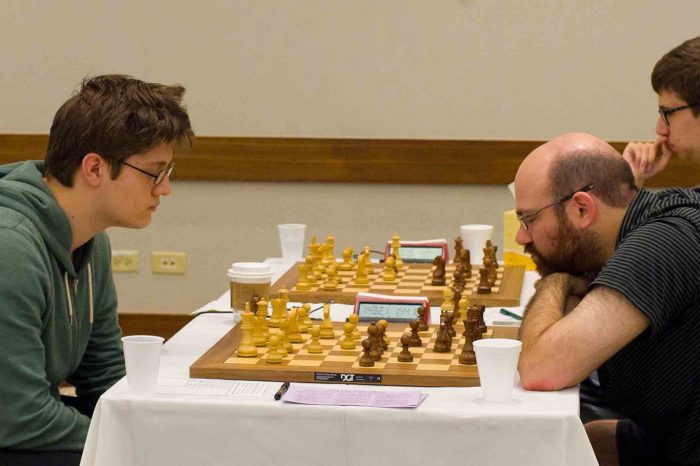 Chicago Open Champion, Samuel Sevian. Photo: Betsy Dynako Zacate
Chicago Open Champion, Samuel Sevian. Photo: Betsy Dynako Zacate
The recently-concluded 26th Annual Chicago Open saw seven players achieve a FIDE norm while 17 year-old GM Samuel Sevian won the overall top prize with a clear first score of 7.5/9. Sevian’s only dings came in the form of draws against fellow GMs Boris Avrukh (round 5), Joshua Friedel (round 8) and Ilia Nyzhnyk (round 9). Sevian’s victory netted him the first place haul of $10,000 and also bumped his USCF rating up to a personal best of 2719.
 Awonder Liang. Photo: Betsy Dynako Zacate
Awonder Liang. Photo: Betsy Dynako Zacate
Leading the pack of norm-getters, IM Awonder Liang achieved his third and final grandmaster norm with a score of 6.5/9. Liang’s only loss came to GM Boris Avrukh in round 3. Once Liang’s GM title is officially awarded, he will become one of the youngest American players to ever achieve the FIDE title.
Some of the notable class section scores included an undefeated 6.5/7 score in the U2300 by FM Andrew Hubbard. Ivan Nitkov, rated 1185 and son of Chicago-area local Nikola Mitkov, also scored an undefeated 6.5/7 to take home clear first in the u1300 section. Combined between the eight sections, 987 players converged on, once more, the Westin Chicago North Shore, where the event has been held for the past several years.
The Sunday night blitz side event was topped by GM Varuzhan Akobian with 9/10, followed closely by GM Andrey Stukopin with 8.5 and, taking clear third, Chicago’s own Gopal Menon, who finished a half-point ahead of the rest of the field at 7.5.
Games from the open section were broadcast live to a large screen in the main playing hall where spectators were treated to several exciting encounters. Once such battle happened between two players who ultimately both were able to finish with a norm, IM Michael Brown and Robert Perez, who met in round 3 in a quick and violent Grunfeld clash.
[pgn][Event "26th Chicago Open"]
[Site "Wheeling, IL"]
[Date "2017.05.26"]
[Round "3.9"]
[White "Brown, Michael"]
[Black "Perez, Robert"]
[Result "0-1"]
[ECO "D83"]
[WhiteElo "2489"]
[BlackElo "2365"]
[Annotator "Karagianis,Pete"]
[PlyCount "54"]
[EventDate "2017.05.??"]
[EventRounds "9"]
[EventCountry "USA"]1. d4 Nf6 2. c4 g6 3. Nc3 d5 4. Bf4 Bg7 5. e3 O-O 6. Rc1 Be6 {One of the main
moves, along with ...c6 and ...c5. This choice, however, has the virtue of
developing a piece.} 7. Qb3 c5 8. Nf3 (8. Qxb7 {immediately is also possible.})
8... Nc6 9. dxc5 Ne4 {A rare move, perhaps preparation?} 10. Qxb7 Qa5 $3 {This
is the move which suggests to me that black may be executing some home-cooked
ideas. Even the engine takes some time to notice the strength behind black's
sacrifice, initially viewing it as simply dead lost.} (10... Rc8 {Seems both
solid and enterprising. Black continues development, defends his knight, and
claims compensation for the sacrificed material.} 11. cxd5 (11. Be2 Nxc5 12.
Qb5 d4) (11. Nxe4 dxe4 12. Nd2 Qa5) 11... Bxc3+ 12. bxc3 Qxd5 13. Be2 Qxc5) 11.
Qxc6 Nxc3 12. bxc3 Bxc3+ 13. Kd1 Rfd8 {This sequence after black's move 10
seemed fairly forced, but now how to defend black's threats?} 14. Bc7 (14. Nd4
{was the other try. After which may follow:} dxc4 {and now the only
independent try is} 15. Ke2 (15. Bc7 Qb4 {returns to the game position.}) (15.
Qc7 Qa3 {doesn't seem an improvement.}) 15... Rac8 16. Qb7 (16. Qb5 Bg4+ 17. f3
Rxd4 {oops.} 18. Qxa5 Rd2+ 19. Ke1 Bxa5) 16... Bg4+ 17. f3 Qxa2+ 18. Rc2 {
White has almost stabilized, except...} Qxc2+ $1 {what a shot!} 19. Nxc2 Rd2+
20. Ke1 Rd7+ $19) 14... dxc4+ 15. Nd4 Qb4 16. Bxd8 Rxd8 17. Qc7 Rd7 18. Qe5 Rd5
19. Qe4 {White attempts to return the queen to the defense, but black's
attacking arrangement is too dangerous.} Bxd4 20. exd4 c3 {There is nothing to
be done about Rxd4. Despite being down a full rook, black's initiative is
difficult to quell.} 21. Bd3 Rxd4 22. Qa8+ Kg7 23. Ke2 Bc4 24. Rcd1 (24. Bxc4
Qxc4+ 25. Ke1 Qd3 {mating.}) (24. Kf1 {running is no respite.} Bxd3+ 25. Kg1
Qb2 26. Re1 c2) (24. Rhd1 Bxd3+ 25. Rxd3 Qb2+) 24... c2 {White is lost, and
black finishes the game directly.} 25. Rd2 Qb2 26. Ke3 Qc3 27. Qf3 Bxd3 0-1[/pgn]
IM Awonder Liang needed every point he could grab to achieve his final GM norm, including his early second round matchup with Anthony He which escalated quickly in the middlegame, resulting in some nice tactics that favored white.
[pgn][Event "26th Chicago Open"]
[Site "Wheeling, IL"]
[Date "2017.05.26"]
[Round "2.15"]
[White "Liang, Awonder"]
[Black "He, Anthony"]
[Result "1-0"]
[ECO "B31"]
[WhiteElo "2488"]
[BlackElo "2307"]
[Annotator "Karagianis,Pete"]
[PlyCount "47"]
[EventDate "2017.05.??"]
[EventRounds "9"]
[EventCountry "USA"]1. e4 c5 2. Nf3 Nc6 3. Bb5 g6 4. Bxc6 bxc6 5. O-O Bg7 6. Re1 Rb8 7. h3 {Played
recently (well, 2015), and with success, by Giri against Grischuk.} Nf6 (7...
Qc7 {was Grischuk's choice.}) 8. e5 Nd5 9. c4 Nc7 10. d4 cxd4 11. Qxd4 Rb7 {a
small jumbling-up of the black queenside pieces, but in this sort of game,
little things matter.} 12. Qh4 Ne6 13. Nc3 f6 {An unnecessary choice and
probably ill-timed, as this only serves to open the e1-rook at white's moment
of choosing.} (13... O-O 14. b3 d5 (14... f6)) 14. Bh6 O-O 15. Bxg7 Kxg7 16. b3
Rb8 {spending a tempo to repair the minor inconvenience caused earlier, but
this tempo was important.} (16... d6 {directly, forcing matters, seems
stronger.} 17. exf6+ Rxf6 18. Ne4 Rf4 19. Qg3 Rf5 {and black seems OK.}) 17.
exf6+ Rxf6 18. Nd4 Nc5 {it is understandable that black did not want to
exhange on d4, allowing the white queen to gain a commanding position, however
now black finds himself in serious trouble.} 19. Qg5 (19. Rad1 {first was
perhaps most accurate, but Qg5 is also strong. Now, white threatens Nxc6!
Black could try to parry this threat by, for example:} Qf8 {but then the same
shot as in the game works-} 20. Nf5+ $1 gxf5 (20... Rxf5 21. Rxe7+ Rf7 22. Qd4+
Kg8 23. Rxf7 Qxf7 (23... Kxf7 24. Qf4+ {it's amazing how much that Rb8-b7-b8
sequence has harmed the black position.}) 24. Qxc5) 21. Qg3+) 19... Nd3 {
Allowing a combo which brings a swift end. Can you spot it?} 20. Rxe7+ $1 Qxe7
21. Nf5+ Rxf5 22. Qxe7+ Kg8 23. Qd6 {there's that Rb8-b7-b8 problem again.} Rb7
24. Qxd3 1-0[/pgn]
 Samuel Sevian vs. Joshua Friedel. Photo: Betsy Dynako Zacate
Samuel Sevian vs. Joshua Friedel. Photo: Betsy Dynako Zacate
Tournament winner and Chicago Open 2017 champion GM Samuel Sevian ran strong all tournament long, but it was arguably his 6th round encounter against then-tournament-co-leader GM Holden Hernandez that may have proved most crucial. After an ill-advised bishop trade, Hernandez found himself in a difficult position, which Sevian was able to finish off with a very nice coup-de-grace.
[pgn][Event "26th Chicago Open"]
[Site "Wheeling, IL"]
[Date "2017.05.28"]
[Round "6.1"]
[White "Sevian, Samuel"]
[Black "Hernandez, Holden"]
[Result "1-0"]
[ECO "B12"]
[WhiteElo "2585"]
[BlackElo "2510"]
[Annotator "Karagianis,Pete"]
[PlyCount "75"]
[EventDate "2017.05.??"]
[EventRounds "9"]
[EventCountry "USA"]
[WhiteClock "0:12:52"]
[BlackClock "0:03:35"]1. e4 c6 2. d4 d5 3. e5 Bf5 4. h4 h5 5. Bd3 Bxd3 6. Qxd3 e6 7. Bg5 Be7 8. Nf3
Nh6 9. Nc3 Nf5 10. Ne2 c5 {Black has been scoring quite well in this line,
according to my database. In fact, after white's response, Sevian is the first
2200+ white player to achieve a win.} 11. dxc5 Qa5+ 12. c3 Qxc5 13. O-O {
Perhaps an improvement on previous play.} (13. Bxe7 {Was Adams - Svidler, 2017
(0-1)}) 13... Bxg5 {Sevian's move, unlike Adams', allows this trade, but
should black make it? Perhaps not. White intends to recapture with his h-pawn
and then instill a knight on d4. Black will then have to deal with the
positional threat g5-g6, which turns out to not be such a simple task.} 14.
hxg5 g6 (14... Nc6 15. g6 {for example.}) 15. b4 Qc7 16. Ned4 Nc6 17. Nxf5 gxf5
18. Rac1 {White hints at an idea of opening central lines in an effort to get
to the black king. Black must find a manner of dealing with this plan - and
fails to do so convincingly.} Rd8 (18... O-O-O $5 {is not entirely
unreasonable, and perhaps should have been played.} 19. Qe3 Kb8 20. a4 h4 {A
classic opposite-side castle position, where both kings will have to deal with
the advance of opposing pawns.}) 19. Rfe1 Ne7 20. Nd4 a6 21. b5 Qc4 22. Qd2 {
Wisely keeping queens on the board. With the presence of her majesty, the
black king will find location of a safe haven to be somewhat difficult.} Ng6
23. bxa6 bxa6 24. Rb1 O-O {The black king makes a bid for safety while also
connecting his rooks to challenge the b-file.} 25. Qd1 {...but h5 is the
drawback.} Rb8 26. Qxh5 Rxb1 27. Rxb1 Qxc3 28. Nxe6 Re8 29. Qh6 $1 Qxe5 30. Nc5
Qd6 {Black has defended well, but his pawns are not the prettiest of sights.}
31. Nd3 Re4 32. Qh2 f4 (32... Qxh2+ 33. Kxh2 Kg7 {might be holdable, but it is
understandable that black did not want to enter into this endgame with four
isolated - and two doubled - pawns.}) 33. Qh3 Ne5 34. f3 Rc4 {Leaving the
e-file unfortunately spells black's doom.} (34... Nxd3 $6 {was an interesting
try.} 35. fxe4 dxe4 {where the passed pawns and the suddenly airy white king
may well compensate for the exchange.}) 35. Re1 $1 {Black has a back rank
problem.} Ng6 36. Re8+ Nf8 37. Qh6 $1 {A nice finishing move. The queen can
neither be tolerated nor exchanged. Black resigns in light of:} Qxh6 (37... Qa3
38. g6) (37... Rc6 38. Rxf8+ Qxf8 39. Qxc6) 38. gxh6 {when h7+ wins the knight.
} 1-0[/pgn]
For more information, visit:
 Chicago Open Champion, Samuel Sevian. Photo: Betsy Dynako Zacate
Chicago Open Champion, Samuel Sevian. Photo: Betsy Dynako Zacate Awonder Liang. Photo: Betsy Dynako Zacate
Awonder Liang. Photo: Betsy Dynako Zacate Samuel Sevian vs. Joshua Friedel. Photo: Betsy Dynako Zacate
Samuel Sevian vs. Joshua Friedel. Photo: Betsy Dynako Zacate






